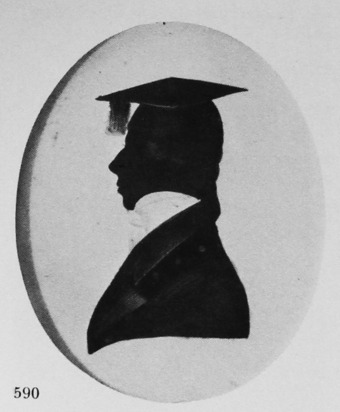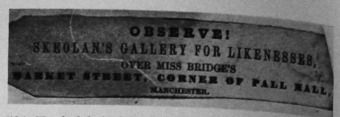Skeolan, Peter (McKechnie Section 1)
Skeolan, P. (fl. 1820-40)
Recorded by Jackson (Dictionary), who also includes an entry on one Eskolan, to whom she gives the date c. 1820 and who was the same artist. She mentions one silhouette in bust-length, four in full-length. One silhouette (illustrated) appears to date from the 1820s and another example, full-length, clearly signed ‘P. Skeolan, 1840’ in the bottom right-hand corner, has been seen. Skeolan, therefore, was probably in practice for at least fifteen years, despite the paucity of his surviving work. He seems to have been a travelling artist, although only addresses in the north of England have been recorded. He certainly visited Halifax (at 16 Waterhouse Street, states Jackson) and Manchester (see the illustrated trade label). In her entry on the artist under his correct name, Jackson mentions that he advertised in the local press on his travels, describing his profiles as ‘faithful, elegant and characteristic, accuracy guaranteed’.
Skeolan’s work is variable in quality. He produced profiles either in plain black (with such details as shirt-collars and cravats left white) or embellished with gold. The gold painting is not always as good as it is on the illustrated example, which is painted against a reddish-brown background similar in colour to that used by Foster. (At first glance, indeed, this silhouette might be thought to be by Foster.) On one full-length example which has been seen, the quality of the gold painting was poor; as few as ten rough strokes of the brush were used to show the hair. The figure was set against a base of foliage in the foreground, with a hill background much in the style of H. A. Frith of the Royal Victoria Gallery. The painting of the base was stiffer and more restrained than that seen on work by Frith.
On the illustrated bust-length example, the cut edge of the work is especially well concealed, paint of the basic colour being added all round the edge of the profile. 2 On the one known trade label the term ‘Skeolan’s Gallery’ is used, so that it is possible that more than one artist produced the work; this might account for the variation of quality. The termination is an almost straight line, dipping to a point in front, but too little of Skeolan’s work has been seen to enable us to establish whether this was a constant feature. This example is housed in a papier mâché frame; known full-length silhouettes were framed in maple.
Under Eskolan, Jackson records a stencil. A trade label, used in Manchester, survives on the reverse of the illustrated silhouette.
Ills. 2, 590, 591

3¾ x 3¼in./96 x 83mm.
Trade label
Frame: papier mâché
Author’s collection

The Reverend Joseph Newton
Cut silhouette, painted against a deep reddish-brown background and with detail painted in gold

Trade label of P. Skeolan, from the silhouette illustrated in 590.
Author’s collection
